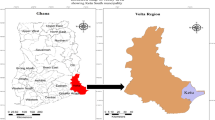Abstract
Sitophilus zeamais Motschulsky is an important field-to-store pest of maize in several parts of Africa including Cameroon. Although synthetic insecticides are effective at controlling the pest, the environmental and health hazards of these chemicals are of increasing concern. This study assesses the efficacy of ashes of local plant material against S. zeamais in the western highlands of Cameroon as an alternative to synthetic insecticides. Laboratory studies on toxicity against F1 progeny of S. zeamais were conducted using leaf ashes of Cupressus arizonica, Eucalyptus grandis, Ocimum gratissimum and root ash of Vetiveria zizanioides at the rates of 0.1, 0.25, 0.5 and 1.0 g/25 g maize grains in Kilner jars. Toxicity of E. grandis ash extract was also evaluated. The ashes of E. grandis and O. gratissimum at the rate of 0.25 g/25 g grains significantly reduced the number of emerged weevils. Eucalyptus grandis ash showed toxicity (1.0 F1 progeny emerging at 0.25 g/25 g grains compared with 16.5 for the control). Eucalyptus grandis ash at 20 g/2 kg grains significantly reduced grain weight loss and protected grains for 6 months without adversely affecting the germination of the seeds. Ethanolic E. grandis ash extracts at rates of 50,000 and 100,000ppm significantly (P, < 0.05) reduced the number of emerged F1 progeny of S. zeamais.
Similar content being viewed by others
References
Abbott W. S. (1925) A method of computing the effectiveness of an insecticide. Journal of Economic Entomology 18, 265–267.
Abdelgaleil S. A. M. and Nakatani M. (2003) Antifeeding activity of limonoids from Khaya senegalensis (Meliaceae). Journal of Applied Entomology 127, 236–239.
Alleoni B. and Baptista G. C. (2002) Control and damage of Rhyzopertha dominica (F.) (Coleoptera: Bostrichidae) on stored corn (Zea mays L.). Revista de Agricultura 77, 79–88.
Appert J. (1970) Insects Harmful to Maize in Africa and Madagascar. Institute of Agronomic Research. 71 pp.
Boeke S. J., Baumgart I. R., Loon J. J. A., Huis A., Dicke M. and Kossou D. K. (2004) Toxicity and repellence of African plants traditionally used for the protection of stored cowpea against Callosobruchus maculatus. Journal of Stored Products Research 40, 423–438.
Bosque-Perez N. A. (1995) Major Insect Pests of Maize in Africa: Biology and control, 2nd edn. IITA Research Guide 30. Training programme. International Institute of Tropical Agricultural (IITA) Ibadan, Nigeria. 30 pp.
Gwinner J., Harnisch R. and Muk O. (1996) Manual on the Prevention of Post-harvest Grain Losses. Post-harvest protection project GTZ Eschborn, FRG, 330 pp.
Halstead D. G. H. (1963) External sex differences in stored product Coleoptera. Bulletin of Entomological Research 54, 119–134.
Hill D. S. (1990) Pests of Stored Products and their Control. Belhaven Press, London. 274 pp.
IITA (1999) Annual Report for 1999. International Institute of Tropical Agriculture (IITA) Ibadan, Nigeria. 82 pp.
Kossou D. K. and Bosque-Perez N. A. (1998) Insect Pests of Maize in Storage: Biology and Control, 3rd edn. IITA Research Guide 32. Training programme. International Institute of Tropical Agriculture (IITA), Ibadan, Nigeria. 28 pp.
Little T. M. and Hills F. J. (1978) Agricultural Experimentaion, Design and Analysis. John Wiley and Sons, New York. 350 pp.
McDonald L. L., Guy R. H. and Speirs R. D. (1970) Preliminary evaluation of new candidate materials as toxicants, repellents and attractants against stored product insects. Marketing research report, number 882 (Washington Agriculture Research Service, United States Department of Agriculture), 8 pp.
Ngoko Z. (1999) Mycotoxin contamination of maize in relation to insect infestation, agricultural practices and agroecology in the Republic of Cameroon. PhD thesis, University of Orange Free State, South Africa, 107 pp.
Ntonifor N. N. and Monah I. M. (2001) Use of three spices to protect stored maize against Sitophilus zeamais. Tropical Science 41, 74–77.
Obeng-Ofori D., Reichmuth C. H., Bekele A. J. and Hassanali A. (1998) Toxicity and protectant potential of camphor, a major component of essential oil of Ocimum kilimandscharicum, against four-stored product beetles. International Journal of Pest Management 44, 203–209.
Ofuya I. T. (1986) Use of wood ash, dry chilli pepper fruits and onion scale leaves for reducing Callosobruchus maculatus (Fabricius) damage in cowpea seeds during storage. Journal of Agriculural Sciences 107, 467–468.
Okalebo J. R., Gathua K. W. and Woomer P. L. (1993) Laboratory methods of soil and plant analysis. A Working Manual. Soil Science Society of East Africa Technical Publication no. 1, Nairobi, Kenya. 88 pp.
Okiwelu S. N., Adu O. O. and Okonkwo V. N. (1987) The effect of Sitophilus zeamais (Mots.) (Coleoptera: Curculionidae) on the quality and viability of stored maize in Nigeria. Insect Science and Its Application 8, 379–384.
Pantenius C. U. (1988) Storage losses in traditional granaries in Togo. Insect Science and Its Application 9, 725–735.
Philogene B. J. (1972) Volcanic ash for insect control. Canadian Entomologist 104, 1487.
Poswal M. A. T. and Akpa A. D. (1991) Current trends in the use of traditional and organic methods for the control of crop pests and diseases in Nigeria. Tropical Pest Management 37, 329–333.
Saayman T. (1997) Protecting stored grain with dust and botanical ashes. Bulletin of the Plant Protection Research Institute 48, 6–9.
Tapondjou L. A., Adler C., Bouda H. and Fontem D. A. (2002) Efficacy of powder and essential oil from Chenopodium ambrosioides leaves as post-harvest grain protectants against six stored product beetles. Journal of Stored Products Research 38, 395–402.
Zhao B., Grant G. G., Langevin D. and MacDonald L. (1998) Deterring and inhibiting effects of quinolizidine alkaloids on spruce budworm (Lepidoptera: Tertricidae) oviposition. Environmental Entomology 27, 984–992.
Author information
Authors and Affiliations
Corresponding author
Rights and permissions
About this article
Cite this article
Akob, C.A., Ewete, F.K. The efficacy of ashes of four locally used plant materials against Sitophilus zeamais (Coleoptera: Curculionidae) in Cameroon. Int J Trop Insect Sci 27, 21–26 (2007). https://doi.org/10.1017/S1742758407699615
Accepted:
Published:
Issue Date:
DOI: https://doi.org/10.1017/S1742758407699615




